|
The
Underwater Secret Lives of
Lingcod
 Our
jumbo-sized white curly tailed
worm lay motionless with a big
hook sticking out of its side.
Flat ocean seas combined with
sunny skies gave us a perfect,
can’t miss picture of the ocean
sixty feet beneath our boat. As
we watched and waited patiently
for one of the curious 10-plus
pound lingcods to bite the tail
instead of just stare at it and
swim by, we developed a quick
but accurate assessment –
lingcod do not like dead bait Our
jumbo-sized white curly tailed
worm lay motionless with a big
hook sticking out of its side.
Flat ocean seas combined with
sunny skies gave us a perfect,
can’t miss picture of the ocean
sixty feet beneath our boat. As
we watched and waited patiently
for one of the curious 10-plus
pound lingcods to bite the tail
instead of just stare at it and
swim by, we developed a quick
but accurate assessment –
lingcod do not like dead bait
At first glance,
the lingcod, whose Latin name,
Ophiodon elongates means long
toothed snake, looks so ugly
only its mother could love it.
In reality though, its mother
would eat it without giving it a
second thought and have a
toothy, I’m-still-hungry-grin
afterwards. Lingcod may be ugly,
even grotesque in appearance and
attitude, but they are one of
the finest eating fish in the
world – and they will bite a
variety of baits and lures if
you know how to trigger the
lingcod into a feeding frenzy.
The underwater
camera tracked several lingcod
that approached our motionless
lure before we decided to
confirm our theory. Years of
experience without the benefit
of a peeping tom camera lens in
the lingcod’s eat-or-be-eaten
underwater world also confirmed
this theory. Now we could put
our experience to test and
confirm our findings on film.
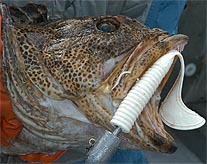 To
test the theory we employed the
best weapon against lingcod that
we know. With a short sweeping
motion of the rod, the white
worm came alive as if it had to
flee for its life. The camera
sent us real-time,
high-resolution color images of
the previously lock-jawed
lingcod springing into attack
mode after the now lively worm.
Lingcod mouths opened wide
exposing dozens of flesh and
lure tearing teeth. Two seconds
after twitching the worm upward
the rod sent waves of energy
down its length to confirm what
our camera had relayed a split
second before the rod shook
violently. To
test the theory we employed the
best weapon against lingcod that
we know. With a short sweeping
motion of the rod, the white
worm came alive as if it had to
flee for its life. The camera
sent us real-time,
high-resolution color images of
the previously lock-jawed
lingcod springing into attack
mode after the now lively worm.
Lingcod mouths opened wide
exposing dozens of flesh and
lure tearing teeth. Two seconds
after twitching the worm upward
the rod sent waves of energy
down its length to confirm what
our camera had relayed a split
second before the rod shook
violently.
First and most
important lesson learned about
lingcod – they want active lures
instead of dead, motionless
baits and lures. After viewing
hundreds of hours of underwater
footage while filming “Underwater
Secrets of Catching Halibut,
Rockfish & Lingcod” with
co-producer Chris Batin, this
lesson became the most important
and repeated lesson about
lingcod.
During our always
fascinating but sometimes boring
filming, we wondered if we were
watching lingcod or they were
watching us! We did learn that
lingcod can be one of the most
curious fish near the bottom.
After lowering new offerings,
whether using dead herring or a
motionless jig, lingcod
approached very closely and
oftentimes just stopped
side-by-side as if waiting for
its quarry to play a deadly game
of tag. Lingcod seemed too
thoroughly enjoy a sporting
pursuit.
 Years
ago, a commercial lingcod angler
told me a trick that helped him
put many lingcod on his
commercial pipe jig off the
coast of Washington. He told me
after pounding his lead-filled
pipe on the bottom he would reel
as fast as he could thirty feet
off bottom, stop reeling, free
spool the jig six feet, reengage
and jerk. He demonstrated the
technique to perfection. As he
explained, after creating lots
of noise with his jig on the
bottom, the action of the jig
fleeing triggered the lingcod
into an attack mode. As the
lingcod pursued the jig it
opened wide enough for the jig
to fall down its throat,
literally. Since his powerful
display of professional lingcod
fishing, I too have used the
super effective technique. A
pipe jig or leadhead jig paired
with skirts or curly tails makes
a life-like jig and allows the
angler to beat the bottom with
sound emitting vibrations. Years
ago, a commercial lingcod angler
told me a trick that helped him
put many lingcod on his
commercial pipe jig off the
coast of Washington. He told me
after pounding his lead-filled
pipe on the bottom he would reel
as fast as he could thirty feet
off bottom, stop reeling, free
spool the jig six feet, reengage
and jerk. He demonstrated the
technique to perfection. As he
explained, after creating lots
of noise with his jig on the
bottom, the action of the jig
fleeing triggered the lingcod
into an attack mode. As the
lingcod pursued the jig it
opened wide enough for the jig
to fall down its throat,
literally. Since his powerful
display of professional lingcod
fishing, I too have used the
super effective technique. A
pipe jig or leadhead jig paired
with skirts or curly tails makes
a life-like jig and allows the
angler to beat the bottom with
sound emitting vibrations.
Commercial
lingcod anglers also used gear
called “dingle bars” that
bounced noisily just off bottom.
This technique worked extremely
well because it took advantage
of the lingcod’s curiosity to
sound, vibration and the lively
looking jigs attached to the
contraption. Our filming
confirmed what commercial
anglers know as fact, that
lingcod are attracted and very
curious about underwater sounds
and vibrations. When we
temporarily lost control of our
multi-thousand dollar camera and
it hit an outcropping or huge
rock, we silently cringed and
hoped the accidental collision
did not cause any damage. The
noise almost always brought
curious fish, including lingcod,
that wanted to see what the
commotion was about.
My son
Christopher, who grew up and
became a commercial diver, also
confirms this fact. During his
last visit after Christmas, he
sport dove Puget Sound’s frigid
waters “just for fun.” That
night he excitingly told me how
lingcod moved toward him and
seemed very curious but kept
just out of his reach. Lingcod
are very curious predators that
inspect anything, regardless of
size, to see if it will fit in
their mouth.
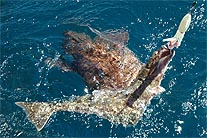 Some
anglers call lingcod “hitch
hikers,” “ride alongs,” “cling
ons,” “high jackers,” or “rough
riders” because they commonly
grab fish already hooked by
anglers. On numerous occasions I
have caught lingcod that refused
to let go of rockfish,
greenling, other lingcod, and
sometimes salmon too. A friend
of mine once landed a 50-pound
lingcod that bit and held onto a
30-pound lingcod that bit and
held a 12-pound coho salmon in
its mouth. Some
anglers call lingcod “hitch
hikers,” “ride alongs,” “cling
ons,” “high jackers,” or “rough
riders” because they commonly
grab fish already hooked by
anglers. On numerous occasions I
have caught lingcod that refused
to let go of rockfish,
greenling, other lingcod, and
sometimes salmon too. A friend
of mine once landed a 50-pound
lingcod that bit and held onto a
30-pound lingcod that bit and
held a 12-pound coho salmon in
its mouth.
Three years ago,
while fishing in Alaska, I
hooked a chicken-sized 12-pound
halibut. After a few seconds of
battle, my smallish halibut
turned into a monster of a fish
and fought hard from 310 feet on
the bottom. Peering into the
inky waters a dark, toothy image
emerged, with my halibut
sideways in its mouth. The
55-pound female lingcod refused
to let go, even with some gentle
coaxing. We finally pried the
ling’s mouth open, held it up
for a quick picture and lowered
it back into the water. My
halibut lay motionless and dead
from multiple lacerations on
both sides of its body.
In addition to
underwater filming, I have
experimented with numerous
colored lures for lingcod.
During one memorable trip to the
Queen Charlotte Islands, I found
a nearshore lingcod lair filled
with dozens of 10-plus pound
lingcod in just 30 feet of
water. Luckily, I had all of the
primary colors to send to the
bottom and watch through the
crystal clear water, which color
of lure the lings preferred.
They reacted to two colors so
favorably it became obvious they
loved chartreuse and hot pink.
At first, I thought these colors
would only be their favorite in
shallow water, but further
experiments proved they love the
same two colors even when
fishing for them beyond 250 feet
deep. They also love white,
another top-producing lingcod
color.
Best Baits
Live baits, where
and when legal, work extremely
well wherever lingcod live. Live
herring, sardines, small sand
dabs, greenling or rockfish are
the same to a lingcod as
offering a Starbuck’s Grande
Latte to a three cup-a-day
coffee addict stuck in
bumper-to-bumper rush hour
traffic. Spreader bars are a
good choice when fishing bait.
They allow you to send the bait
to the bottom rapidly without
tangling the mainline. To avoid
loosing anything but your
weight, tie a 20-pound test,
24-inch leader to the swivel on
the bottom of the spreader bar,
then tie the leader to the 8- to
24-ounce weight.
Best Lures
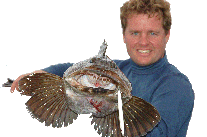 Leadhead
and pipe jigs work extremely
well when kept jigging up and
down and occasionally pounded on
the bottom. Point Wilson Darts,
Stingers and other baitfish
imitating jigs also work well,
but must be kept off bottom and
out of the rocks. These baitfish
jigs weigh less than pipe or
leadhead jigs and offer a
completely different element of
sport. When using lighter jigs,
light weight rods provide more
fun and fight, especially when
fighting big lingcod. And with
lighter jigs it is much easier
to maintain a lively
presentation without wearing out
your body. Leadhead
and pipe jigs work extremely
well when kept jigging up and
down and occasionally pounded on
the bottom. Point Wilson Darts,
Stingers and other baitfish
imitating jigs also work well,
but must be kept off bottom and
out of the rocks. These baitfish
jigs weigh less than pipe or
leadhead jigs and offer a
completely different element of
sport. When using lighter jigs,
light weight rods provide more
fun and fight, especially when
fighting big lingcod. And with
lighter jigs it is much easier
to maintain a lively
presentation without wearing out
your body.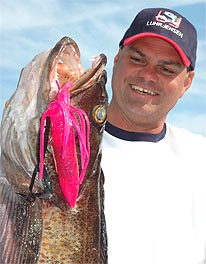
Where Lingcod
Live, Work, Date & Eat
Male lingcod
inhabit rocky, rough bottom
terrain nearshore and offshore
in depths ranging from 50 to 150
feet deep. Mature males range in
size from four to 12 pounds –
almost never exceeding
14-pounds. The male will guard
his territory all year in hopes
of attracting a female during
spawning season. This
territorial behavior results in
bone-jarring hits that fool you
when trying to guess the size of
fish hooked. Most summertime
fishing pressure is from private
boat anglers fishing nearshore
shallow reefs. Some female
lingcod, ranging in size from 12
to 60+ pounds, also inhabit
these areas, especially after
spawning season. (Large female
lingcod should be released to
help sustain healthy
populations).
Most mature
female lingcod inhabit offshore
underwater reefs and banks
surrounded by much deeper water
than where males call home.
These offshore rugged and rocky
bottoms range in depth from 150
to 600 feet deep. Female lingcod
spawn annually from November
through April, depending on
location and water temperature.
During their spawning cycle,
they move from deep waters into
shallow, inter tidal zones that
have rocky bottoms or lots of
crevices to hide and deposit
their eggs. Depending on their
size, lady lings deposit 60,000
to 500,000 eggs. The bulky mass
of eggs attach to a rocky
substrate. A male will then
fertilize the eggs, stand guard
and fan water over the eggs for
approximately six weeks until
they hatch.
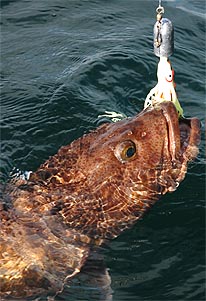 The
"ideal" location to find hungry
and aggressive lingcod will have
steep, rough, rocky crevices
with strong tidal currents
flowing over the reef or bank.
"Lingcod tend to lay in the
upside of the current flow over
a rock. They wait for their
prey to flow over them so
they'll lay in these hydraulic
liaisons and jump on prey going
over them," explained Tom
Jadiello, Washington Department
of Fisheries Lingcod Biologist. The
"ideal" location to find hungry
and aggressive lingcod will have
steep, rough, rocky crevices
with strong tidal currents
flowing over the reef or bank.
"Lingcod tend to lay in the
upside of the current flow over
a rock. They wait for their
prey to flow over them so
they'll lay in these hydraulic
liaisons and jump on prey going
over them," explained Tom
Jadiello, Washington Department
of Fisheries Lingcod Biologist.
How to Look For
Lingcod Habitat
Use large scale
nautical charts (1:10,000) or
(1:40,000) to look for extreme
changes in bottom depth. Look
for reefs and banks. With the
use of a fish finder/GPS unit,
you can locate areas from your
chart. Once you stop on a likely
looking lingcod area, ALWAYS
fish downhill, from the top of
the structure to the bottom,
while drifting with the current.
Proper planning of your drift
will keep you from losing
expensive lures.
While the bait or
lure is moving down the steep
terrain, keep letting out enough
line to keep it as close to the
bottom as possible without
snagging. Whether using bait or
artificial lures, bounce the jig
or weight on the bottom, never
drag it. Every few minutes, reel
the bait/lure off the bottom 30
or 40 feet, then free spool back
to the bottom. If the jig or
bait stops or in anyway pauses,
jerk, it might be a lingcod.
Size Limits &
Restrictions
Always be aware
of size limits when lingcod
fishing. Many areas now have
slot limits that only allow
anglers to take lingcod that
fall within this range. This
size range allows us to keep the
best eating size lingcod in the
8 to 18-pound range. Large
females should always be
released and respected for their
spawning value. If forced by
regulation or you make the
choice to release a lingcod, for
whatever reason, rest assured,
they will survive the ordeal.
Unlike rockfish, lingcod do not
have air bladders – they can
swim freely throughout the water
column without injury.
Proper care of
your catch will result in
"prime" fresh fish. Immediately
after landing a lingcod
carefully measure its size. If
legal, cut through its
gill-rakes and allow it to bleed
out. Put your catch on ice
immediately and it will be among
the best white fleshed meat you
have ever brought home.
About the Author
John L. Beath is
the Northwest editor and lives
in Monroe Washington. He began
fishing for lingcod at age
eight, 40 years ago. His video,
Underwater Secrets of
Catching Halibut, Rockfish &
Lingcod & lots of
lingcod fishing tackle can be
purchased at the
lingcod fishing tackle store
on this site.
|